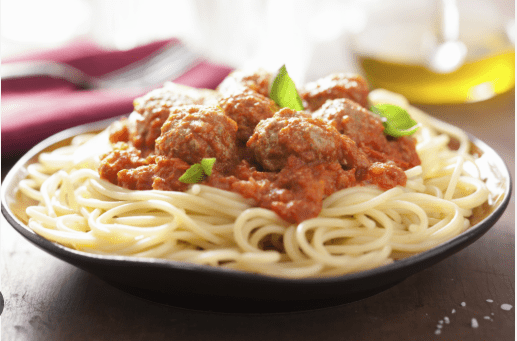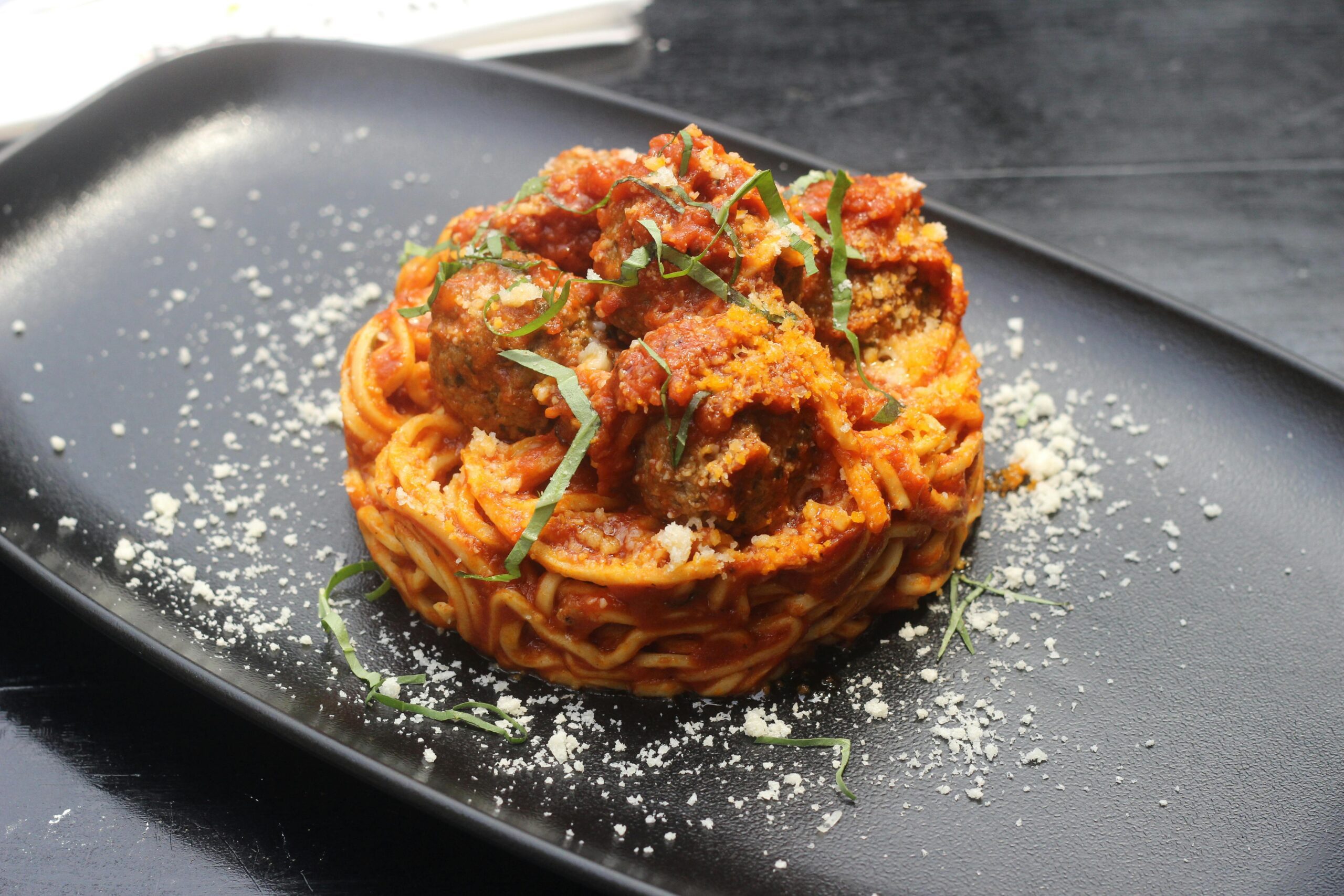Spaghetti and Meatballs Nutrition: What’s Really in Your Bowl?

A comforting culinary staple that evokes recollections of comfortable dining establishments and home-cooked evenings is spaghetti and meatballs. Although it appeals to taste and memories, many people wonder if it’s truly healthful. Understanding the nutritional makeup of spaghetti and meatballs may be quite beneficial, whether you’re attempting to reduce weight, eat healthier, or simply comprehend what’s nourishing your body.
To help you enjoy your favorite meal guilt-free (or at least make it a bit healthier!), let’s break down everything you need to know, from protein and calorie content to health advantages and wise substitutions.
A Quick Look at Spaghetti and Meatballs Nutrition Facts
Here is a broad nutritional overview of a typical dish of spaghetti and meatballs (about two cups pasta, three medium meatballs, and tomato sauce) before getting any more deeply:
| Nutrient | Approximate Value |
| Calories | 600–800 kcal |
| Carbohydrates | 70–90g |
| Protein | 25–30g |
| Fat | 20–30g |
| Saturated Fat | 8–12g |
| Sodium | 900–1200mg |
| Fiber | 5–7g |
| Sugar | 6–12g |
| Iron | 15–20% DV |
| Vitamin C | 10–15% DV |
Note: These numbers vary based on portion size, meat type, pasta brand, and sauce recipe.
What Impacts the Nutrition?
You may cook spaghetti and meatballs as light or decadent as you choose. The final nutrient count is heavily influenced by a few essential ingredients:
1. The Meat
You may prepare meatballs and pasta either lightly or as rich as you like. A number of key components have a significant impact on the ultimate nutritional are significant:
2. The Pasta
Because white pasta is formed out of processed wheat, it has fewer carbohydrates and causes glucose levels to rise more rapidly. The fiber and protein from whole grain or pasta made with chickpeas enable you to feel fuller for extended.
3. The Sauce
Naturally nutritious, tomato-based sauce becomes particularly beneficial whenever prepared from home. However, bought from a store alternative can have excessive salt content, preservation agents, and additional sweeteners. You have more power if you understand the markings or make decisions on your own.
4. The Portions
It depends how big your portion is. A “normal” dining amount may be twice as large as what is advised. Keeping an eye on the size of your portions allows you to control your calorie consumption without negatively affecting your happiness.
Health Benefits of Spaghetti and Meatballs
Inconceivable that this filling dish offers certain nutritional advantages, particularly when prepared with nutritious components and consumed in proportion.
1. Great Source of Protein
Rich in protein, meatballs aid in testosterone synthesis, immunological response, and regrowth of muscles. You may get all of these benefits with no the additional added cholesterol by choosing nutritious meat or based on plants substitutes.
2. Steady Energy from Carbs
The human body utilizes the complicated carbs in pasta dishes as fuel. In comparison with processed pasta, pure grain noodles releases carbohydrates more gradually and continuously.
3. Rich in Iron and B Vitamins
Meat, specifically beef, is a great source of zinc, iron, as well as the B12 vitamin. These are all essential for maintaining your stamina reserves and producing red blood cells.
4. Antioxidants from Tomatoes
This compound, a potent antioxidant associated with heart health and a lower risk of malignancies, is abundant in sauce made with tomatoes. This compound bioavailability is actually increased when peppers are cooked, making the sauce you use a nutritious dynamo.
Health Concerns and Downsides
Even while meatballs and spaghetti have numerous advantages, they don’t always constitute good for you. Here are some nutritional problems to be aware of:
1. High in Calories
A single serving may have 600–900+ calories, dependent on how it is prepared. If you don’t watch how much you eat or serve it with wine and bread made with garlic, the calories can build up rapidly.
2. Saturated Fat Overload
Saturated fat, which has been implicated to heart problems whenever consumed in excessive quantities, can be found within conventional beef or meatballs. It is preferable to use slimmer protein.
3. Excess Sodium
Traditional beef and meatballs include fat that is saturated, that is frequently linked to cardiac issues anytime it is ingested in overabundance. A thinner person protein is the better option.
4. Blood Sugar Spikes
Conventional beef and meatballs contains high levels of saturated fat, which is frequently connected with heart problems if it gets consumed in excess. Proteins from a leaner individual is preferable.
Tips for a Healthier Plate of Spaghetti and Meatballs
Do you are interested in savor this dish of food guilt-free? Listed below are a few wise changes and modifications:
✅ Use Lean or Plant-Based Meat
Would you like to take pleasure in this meal with no feeling ashamed? Here are some sensible adjustments and modifications:
✅ Try Whole Wheat or Veggie Pasta
Spiralized zucchini, which are vegetables macaroni squash, or pasta made from chickpeas are low-carb or without gluten substitutes, while eating whole-grain pasta increases fiber.
✅ Make Your Own Sauce
Avoid packages that are laden with sugar. It is simpler and more tasty to make your own tomato sauce using garlic, onions, olive oil, and seasonings.
✅ Add Veggies to the Mix
Add vegetables like bell peppers, zucchini, spinach, or mushrooms to boost the volume and nutrient richness without adding a lot of additional calories.
✅ Control the Portion Size
To increase the amount contained and nutrient diversity without significantly increasing the calorie content, use vegetables such as red bell peppers, zucchini, leafy greens such or mushrooms.
Is It Okay for Special Diets?
If you choose your components carefully, you may modify spaghetti and meatballs so that they fit within most diets:
🍝 Low-Carb/Keto
Instead of crumbs of bread, use almond meal to create meatballs with shirataki or zucchini spaghetti.
🍝 Diabetic-Friendly
Lean protein, homemade sauce without extra sugar, and whole wheat pasta are the best options. To control carbohydrate consumption, keep servings small.
🍝 Gluten-Free
Make sure your meatballs and sauce don’t include any hidden gluten (breadcrumbs, soy sauce, etc.) and choose gluten-free pasta that has been verified gluten-free.
🍝 Vegetarian/Vegan
Use dairy-free parmesan and meatballs made from lentils, beans, or tofu. It’s simple to keep it plant-based using tomato sauce and vegetable spaghetti.
The Final Verdict: Is Spaghetti and Meatballs Healthy?
So, is this comfort food classic good for you?
It depends.
Saturated fat, salt, and calories can be high in traditional spaghetti and meatballs, especially when served in big servings with fatty meats and sweet sauces. However, with a few easy changes—leaner meat, nutritious grains, vegetable additions, and homemade sauce—it can definitely be included in a meal that is balanced.
Mindful ingredients and moderation are crucial. There’s no reason to stop eating a food you enjoy. Rather, figure out how it may benefit your body and your objectives.
Frequently Asked Questions
1. How many calories are in spaghetti and meatballs?
Based on ingredients and portion size, a normal serving has 600–800 calories. This amount can be decreased by using whole grain pasta and lean meat.
2. Is spaghetti and meatballs a good source of protein?
Indeed! Lean meats or plant-based substitutes can be added to meatballs to boost their protein level.
3. Can I eat spaghetti and meatballs on a diet?
Of course. Simply pay attention to the amount of food you eat, the ingredients you use, and make an effort to increase the number of vegetables and fiber in your meal.
Conclusion
Although spaghetti and meatballs don’t exactly scream “health food,” they don’t have to be a guilty pleasure if prepared properly. You can make this comfort food staple into a filling and healthy supper by making wise ingredient and preparation choices.
Keep the health tips in mind and indulge in a dish of flavourful meatballs and saucy spaghetti the next time you’re wanting it. After all, eating healthily is about balance, not perfection.
